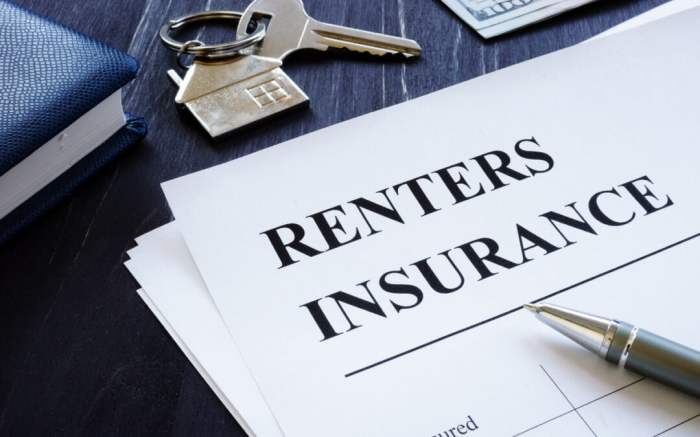Unexpected events can strike anytime, leaving you vulnerable and financially strained. Apartment insurance, often overlooked, acts as a crucial safety net, shielding your belongings and providing liability coverage in unforeseen circumstances. This comprehensive guide delves into the intricacies of apartment insurance, empowering you to make informed decisions and secure your future.
From understanding the various coverage options and cost factors to navigating the claims process and selecting the right provider, we’ll equip you with the knowledge to choose the apartment insurance policy that best suits your needs. We’ll explore real-life scenarios to illustrate the importance of this often-underestimated protection.
Factors Affecting Apartment Insurance Costs

Several key factors influence the cost of apartment insurance premiums. Understanding these factors can help renters make informed decisions and potentially save money on their coverage. These factors interact in complex ways, so a thorough assessment is recommended before choosing a policy.
Location of the Apartment
The location of your apartment significantly impacts your insurance premium. Apartments in high-crime areas or areas prone to natural disasters (like floods, earthquakes, or wildfires) will generally command higher premiums. Insurance companies assess risk based on historical claims data for specific geographic locations. For example, an apartment in a coastal city with a history of hurricanes will likely be more expensive to insure than a similar apartment in a landlocked, less disaster-prone region. Similarly, apartments in areas with high rates of theft or vandalism will reflect those higher risks in premium costs.
Coverage Amount and Type
The level of coverage you choose directly affects your premium. Higher coverage limits for personal belongings mean higher premiums. The type of coverage also matters. Comprehensive policies that include liability protection and additional coverage options, such as for water damage or identity theft, will typically cost more than basic policies. Consider your individual needs and risk tolerance when selecting coverage levels; a higher deductible will generally lower your premium, but you will pay more out-of-pocket in the event of a claim.
Building Features and Security
The building’s features and security measures can influence your insurance costs. Apartments in buildings with robust security systems, such as security cameras, controlled access, and fire suppression systems, might receive lower premiums. Conversely, buildings lacking these features may be considered higher risk, resulting in increased premiums. The age and condition of the building also play a role; older buildings may present a higher risk of damage or require more extensive repairs.
Your Credit Score
In some regions, your credit score can be a factor in determining your apartment insurance premium. Insurance companies may view a lower credit score as an indicator of higher risk, potentially leading to higher premiums. Maintaining a good credit score can be a significant factor in obtaining more affordable insurance rates.
Ways to Reduce Apartment Insurance Costs
Several strategies can help renters reduce their apartment insurance costs. It is crucial to shop around and compare quotes from multiple insurers to find the best rates.
- Compare quotes from multiple insurers.
- Increase your deductible.
- Bundle your insurance policies (e.g., renters insurance with auto insurance).
- Maintain a good credit score.
- Consider a shorter policy term if possible.
- Review your coverage needs annually and adjust accordingly.
Filing a Claim with Apartment Insurance
Filing a claim with your apartment insurance provider can seem daunting, but understanding the process and having the necessary documentation can significantly ease the experience. This section Artikels the steps involved, the required paperwork, and examples of situations that necessitate filing a claim. Remember to always refer to your specific policy for detailed instructions and coverage limits.
The process generally involves reporting the incident to your insurance company, providing detailed information about the damage, and cooperating with their investigation. Your insurer will then assess the claim, determine the extent of coverage, and ultimately authorize repairs or provide financial compensation.
Required Documentation for an Insurance Claim
Supporting your claim with comprehensive documentation is crucial for a smooth and efficient process. Insufficient documentation can lead to delays or even claim denial. Therefore, gather as much relevant information as possible immediately following the incident.
This typically includes, but is not limited to, photographs or videos of the damage, repair estimates from qualified professionals, police reports (if applicable, such as in the case of theft or vandalism), receipts for any related expenses incurred, and a detailed description of the events leading to the damage. Your insurance policy and contact information are also essential.
Examples of Situations Requiring a Claim
Numerous situations may necessitate filing an apartment insurance claim. Understanding these scenarios can help you determine when to contact your insurer.
Examples include fire damage, water damage from a burst pipe or leaky roof, theft or vandalism, and damage caused by severe weather events such as hailstorms or tornadoes. Other examples might include accidental damage, such as a broken window or damaged appliance, provided it’s covered under your policy. It is important to note that not all damages are covered, and you should carefully review your policy for specific exclusions.
Step-by-Step Guide to Filing a Claim
Filing a claim involves a series of steps designed to ensure a thorough investigation and fair resolution. Following this process will help streamline the claims process.
- Report the Incident: Contact your insurance company immediately after the incident occurs. Note down the date, time, and details of your conversation with the representative.
- Gather Documentation: Collect all relevant documentation, as Artikeld above. This includes photos, repair estimates, police reports, and receipts.
- Submit the Claim: Submit your claim using your insurer’s preferred method (online portal, mail, or phone). Ensure all required documentation is included.
- Cooperate with the Investigation: Your insurer may require additional information or inspections. Cooperate fully and promptly to avoid delays.
- Review the Settlement: Once the claim is processed, carefully review the settlement offer to ensure it accurately reflects the damages and your policy coverage.
Understanding Exclusions and Limitations

Apartment insurance, while offering valuable protection, isn’t a blanket guarantee against all potential losses. Understanding the exclusions and limitations within your policy is crucial to avoid disappointment and financial hardship when you need to file a claim. These limitations define what events or damages your policy will *not* cover. Failing to grasp these specifics can lead to unexpected out-of-pocket expenses.
It’s important to remember that insurance policies are legally binding contracts. The terms and conditions, including exclusions and limitations, are carefully defined to manage risk and determine the insurer’s liability. Ignoring the fine print can significantly impact your ability to recover losses after an incident.
Common Exclusions and Limitations in Apartment Insurance Policies
Many standard apartment insurance policies exclude coverage for certain types of damage or events. These exclusions are often designed to prevent fraud or to manage risk effectively. Understanding these common exclusions allows you to better assess your personal risk and potentially seek additional coverage if needed.
- Earthquakes and Floods: Most standard policies do not cover damage caused by earthquakes or floods. These events often result in widespread damage, creating significant financial strain on insurance companies. Separate, specialized policies are typically needed for these specific risks.
- Intentional Acts: Damage caused deliberately by the policyholder or someone acting on their behalf is generally excluded. This prevents people from intentionally causing damage and then claiming insurance.
- Negligence: While the policy covers accidental damage, negligence that leads to significant loss may not be fully covered. For example, leaving a faucet running for an extended period and causing significant water damage may result in a reduced payout.
- Wear and Tear: Normal wear and tear on your belongings is not covered. This refers to the gradual deterioration of items due to age and use. For example, a worn-out carpet wouldn’t be covered.
- Specific Valuables: High-value items like jewelry, artwork, and electronics may require separate riders or endorsements to ensure adequate coverage. Standard policies may limit the amount of compensation for these items.
Implications of Exclusions and Limitations
The implications of policy exclusions and limitations can be significant. Understanding these limitations allows you to make informed decisions about your coverage needs and to prepare for potential financial responsibility in the event of a loss.
For example, if a flood damages your apartment and your policy excludes flood damage, you will be responsible for the entire cost of repairs and replacement of your belongings. Similarly, if you intentionally damage your apartment, you will not receive any compensation.
Examples of Situations Where Coverage Might Be Denied
Several situations illustrate how exclusions and limitations can lead to denied claims. It is crucial to carefully review your policy wording to avoid unexpected financial burdens.
Consider the following scenarios: A tenant leaves a window open during a severe storm, resulting in significant water damage to their apartment. While the storm itself may be covered, the negligence of leaving the window open could lead to a partial or complete denial of the claim. Another example: A fire starts due to a faulty appliance, but the policy excludes coverage for damages caused by faulty electrical equipment not regularly maintained. In this case, the claim could be denied if the tenant had not taken appropriate measures to maintain the appliance.
The Importance of Understanding the Fine Print
Reading and understanding your apartment insurance policy’s fine print is paramount. Don’t hesitate to contact your insurance provider to clarify any ambiguities or uncertainties. A thorough understanding of your coverage will protect you from unexpected financial burdens in the event of an incident. This proactive approach will ensure you have the appropriate level of protection tailored to your specific needs and circumstances.
Illustrating Common Apartment Insurance Scenarios
Apartment insurance, while often overlooked, provides crucial protection against unforeseen events. Understanding how it responds in various situations is key to appreciating its value. The following scenarios illustrate common claims and the typical claims process.
Fire Damage in an Apartment Building
Imagine a fire breaks out in your apartment building, originating in a neighboring unit. The fire spreads, causing significant damage to your apartment. Smoke and soot damage your furniture, electronics, and clothing. Water damage from the firefighters’ hoses further exacerbates the situation. Your apartment is deemed uninhabitable. With apartment insurance, you would file a claim detailing the damages, providing photographic evidence and receipts where possible. Your insurer would then assess the damage, potentially sending an adjuster to inspect the property. Depending on your policy coverage and deductible, the insurance company would cover the cost of repairing or replacing your damaged belongings, as well as providing temporary housing while repairs are undertaken. The claims process might involve multiple interactions with your insurer and potentially negotiating the settlement amount. The entire process can take several weeks or even months, depending on the extent of the damage and the complexity of the claim.
Theft of Personal Belongings
Consider a scenario where you return to your apartment to find that it has been burglarized. Valuables, including a laptop, jewelry, and a high-end camera, are missing. Immediately, you contact the police to file a report, obtaining a copy of the report as proof of the incident. You then contact your insurance company to file a claim, providing the police report, a detailed list of stolen items, and any supporting documentation such as purchase receipts or appraisals. The insurer will investigate the claim, possibly requiring you to provide additional information. They will then determine the value of the stolen items based on their replacement cost, considering depreciation where applicable. Your payout will be subject to your policy limits and deductible. The process may involve verifying the value of the stolen goods and providing proof of ownership.
Water Damage from a Burst Pipe
A sudden burst pipe in your bathroom floods your apartment, causing extensive water damage. Your carpets are soaked, your walls are damaged, and your furniture is ruined by the water and resulting mold. You immediately contact your building management and your insurance provider. You then file a claim with your insurer, providing detailed descriptions and photographic evidence of the damage. An adjuster will likely visit to assess the extent of the damage and determine the cost of repairs or replacements. The insurance company will cover the cost of repairs or replacements for the damaged items, subject to your policy limits and deductible. They may also cover the cost of temporary housing if your apartment becomes uninhabitable during repairs. The claim process will involve working closely with the insurer and potentially contractors to restore your apartment to its pre-damage condition.
Closing Notes

Securing adequate apartment insurance is a proactive step towards financial security and peace of mind. By understanding the different coverage options, factors influencing costs, and the claims process, you can confidently choose a policy that aligns with your individual circumstances. Remember, the investment in apartment insurance is a small price to pay for the significant protection it offers against life’s unpredictable events.
Frequently Asked Questions
What is the difference between apartment insurance and renter’s insurance?
The terms are often used interchangeably; they essentially refer to the same type of insurance protecting renters’ belongings and liability.
Is flood insurance included in a standard apartment insurance policy?
Usually not. Flood insurance is typically purchased separately.
What if my landlord has insurance; do I still need apartment insurance?
Your landlord’s insurance covers the building, not your personal belongings or liability. You need your own coverage.
How long does it take to get a claim approved?
Processing times vary depending on the insurer and the complexity of the claim, but it can range from a few days to several weeks.
Can I choose my own repair company after a covered incident?
Some insurers may have preferred vendors, but you often have the option to choose your own, subject to insurer approval.